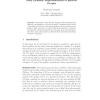43 search results - page 2 / 9 » Fully dynamic algorithms for chordal graphs and split graphs |
WALCOM
2010
IEEE
14 years 15 days ago
2010
IEEE
Given a simple graph G, a harmonious coloring of G is a proper vertex coloring such that each pair of colors appears together on at most one edge. The harmonious chromatic number i...
IWOCA
2009
Springer
14 years 2 days ago
2009
Springer
We discuss various questions around partitioning a split graph into connected parts. Our main result is a polynomial time algorithm that decides whether a given split graph is full...
DAM
2008
13 years 5 months ago
2008
Polar graphs are a common generalization of bipartite, cobipartite, and split graphs. They are defined by the existence of a certain partition of vertices, which is NPcomplete to ...
ANOR
2005
13 years 5 months ago
2005
In Hell et al. (2004), we have previously observed that, in a chordal graph G, the maximum number of independent r-cliques (i.e., of vertex disjoint subgraphs of G, each isomorphic...
WG
2009
Springer
14 years 3 days ago
2009
Springer
We present a fully dynamic algorithm that maintains three different representations of an interval graph: a minimal interval model of the graph, the PQ-tree of its maximal cliques...

